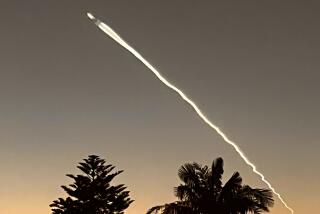X-43A Aircraft Sets Speed Record at 6,500 MPH
- Share via
EDWARDS AIR FORCE BASE — NASA’s supersonic surfboard, the unmanned X-43A aircraft, streaked into history Tuesday, setting an unofficial world speed record for jet aircraft of Mach 9.6, or about 6,500 mph.
The aircraft -- powered by an experimental engine known as a scramjet -- was carried to an altitude of 40,000 feet under the wing of a B-52 bomber and released at about 2:30 p.m.
A Pegasus rocket booster accelerated the X-43A -- a rectangular disc of metal with fins at the back -- before the scramjet on the underside of the aircraft took over, shooting the craft to its record-breaking run at 111,000 feet.
The scramjet burned for about 10 seconds, before flaming out and plunging into the Pacific Ocean about 800 miles off the California coast, officially ending the X-43A program after three flights.
“We had a phenomenal flight today. Everything went really well,” said Laurie Marshall, the chief engineer for the flight, speaking at a news conference that turned into a celebration of the program’s achievements.
The flight was part of a $230-million project aimed at showing the capabilities of a new breed of jet aircraft that could conceivably speed passengers across country in minutes and send passengers into space far more cheaply than today.
“What NASA does is open doors,” said Griff Corpening, the senior advisor to the X-43A program at the Dryden Flight Research Center. “We’ve just opened the door to Mach 10 flight for jet aircraft.”
The heart of the X-43A is its revolutionary scramjet -- a contraction of Supersonic Combustion Ramjet. The engine compresses air at hypersonic velocities and ignites it in a hydrogen mixture.
Most commercial aircraft today use turbines to compress air, which ignites with kerosene to create combustion and thrust. Air flows are too low to produce high speeds with those engines.
Engineers developed the ramjet decades ago to solve those problems. A ramjet is basically a hollow tube with no moving parts; air flows into the front of the ramjet, is compressed and mixed with fuel. But the ramjet cannot go faster than Mach 5, or five times the speed of sound. Mach 1 is about 680 mph, depending on atmospheric conditions.
The ramjet’s limitations led to development of the scramjet, in which gases flow into the ignition chamber at supersonic speeds. The igniting substance is called Silane, which explodes in the presence of oxygen.
Compared with rocket-powered vehicles such as the Space Shuttle, scramjet vehicles promise more airplane-like operations to improve safety and keep costs down on future hypersonic flights either in or below orbit.
To cope with the extreme heat at hypersonic velocities, the X-43A has a tungsten nose with carbon-carbon leading edges. At Mach 10, temperatures reach 3,700 degrees Fahrenheit.
The top of the vehicle is as flat as a bowling alley. The scramjet engine, essentially a copper box, is suspended from the underside of the plane.
During its 10-second engine burn Tuesday, the X-43A traveled nearly two miles a second. At that speed, a trip to New York from Los Angeles would take about 20 minutes.
There remain a number of hurdles, however, before scramjets could be introduced to commercial flight. The primary one is that the engine won’t work at speeds less than Mach 4.
One answer might be to include more conventional engines on board to lift the plane off the ground.
Another solution would be to attach it to a rocket, though that would require future passengers to become comfortable with the chin-stretching forces of rocket takeoffs.
In the near term, scramjets are more likely to be used on bunker-busting missiles.
Asked if scramjets could be used for commercial transportation, X-43A project manager Joel Sitz, said: “Absolutely.” But he added, “Who knows when it will be.”
Until this year, the speed record for a jet aircraft was 2,100 mph, about Mach 3, established by the SR-71 spy plane.
The first X-43A test in 2001 was a failure. The craft went out of control during the booster phase. The first successful test of a scramjet engine was March 27, when the X-43A hit a top speed of 5,000 mph, or Mach 7, before being ditched into the ocean.
The latest flight was originally scheduled for Monday, but was delayed a day after computer problems developed in the avionics of the vehicle.
The hypersonic plane was designed by Boeing Co. at its Huntington Beach facility and built by ATK-GASL in Ontario and Tullahoma, Tenn.
Several other countries, notably France, Japan and Australia, also are moving forward with scramjet projects.
Tuesday also marked the last test flight for the B-52, which has been launching test vehicles since the X-15 in the 1960s.
As it took off, it headed up at an unusual nose-up attitude that NASA officials said was intended as a final salute.
More to Read
Sign up for Essential California
The most important California stories and recommendations in your inbox every morning.
You may occasionally receive promotional content from the Los Angeles Times.













